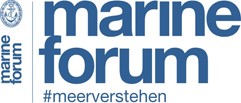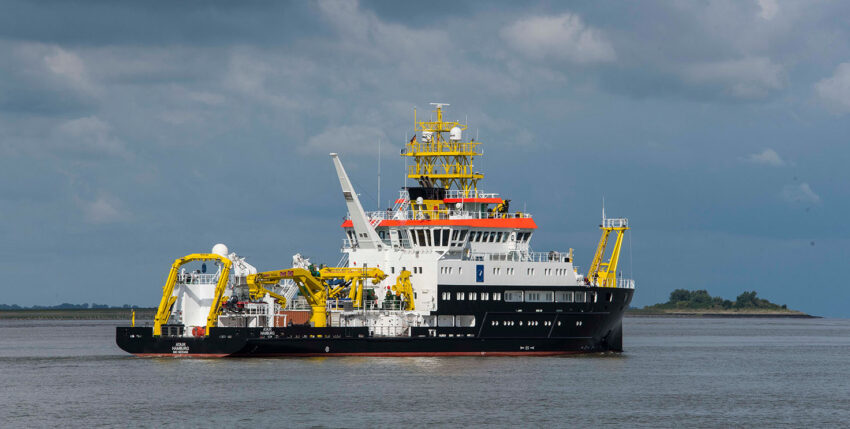The new survey, wreck search and research vessel Atair
75 metres long, around 17 metres wide, a draught of five metres and a speed of around 13 knots characterise the Atairthe first seagoing government vessel for specialised tasks with LNG propulsion, low-noise and awarded the Blue Angel for energy-efficient design. Around 6000 drawings and documents were produced in more than 300,000 hours of design work. The ship contains 1300 tonnes of steel. 180 kilometres of cable and 92 tonnes of pipe were laid on board. 5500 measuring points were programmed. In September 2020, the Federal Maritime and Hydrographic Agency (BSH) accepted the ship. It was officially put into service for the Federal Republic of Germany at the end of April 2021. The first voyages for the central maritime authority have already been completed.
The Fassmer shipyard, which was commissioned to realise the ship planned by the Federal Waterways Engineering and Research Institute, faced major challenges: The technically complex requirements that a surveying, wreck search and Research vessel had to be realised in an efficiently functioning, economical and environmentally friendly ship design. The fulfilment of high requirements for environmental protection and noise emissions, extensive scientific and technical equipment and a state-of-the-art integrated bridge system were to make this newbuild unique and give it a pioneering role in the field of German ships for special tasks.
LNG drive
To fulfil the environmental requirements, the ship has a diesel-gas-electric propulsion and energy concept with an output of 3100 KW. It is equipped with two dual-fuel engines, one of which is operated exclusively in gas mode with LNG (liquefied natural gas), currently the most environmentally friendly marine propulsion system. With a 130 cubic metre LNG tank, the ship can sail for ten days on LNG propulsion alone. The diesel-powered engines have been equipped with modern exhaust gas aftertreatment and a soot particle filter in compliance with IMO Tier III. For diesel operation, which is also possible, only gas oil with a sulphur content of less than 0.1 per cent is used. Where possible, the ship is fuelled exclusively with LNG. However, with this equipment, it can also be used in areas where LNG is not available.

Silent-R ship
The Atair fulfils first Research vessel In Germany, the new "Silent R" requirements, which define the maximum permissible very low underwater noise level. In addition to protecting the environment and, above all, marine animals, this provides optimum conditions for scientific work on board. As the Atair has a large number of hydroacoustic devices, the requirements for the ship's underwater noise level are high. Above all, the ship's own noise should not interfere with the hydrographic measurements so as not to distort the quality of the results. This requirement in itself has a strong influence on the entire ship design, which fulfils the requirements of the Blue Angel eco-label for environmentally friendly ship design in accordance with RAL-UZ 141. The steel structure, the foundations and bearings of all noise-generating components, the propulsion system, the propeller, the insulation, the equipment and furnishings are designed and built in accordance with the acoustic requirements. For example, the ship's drive train consists of a low-vibration and low-noise electric motor that acts on an equally quiet and cavitation-free seven-bladed propeller - a technology previously only found on submarines. The shape of the hull also has an influence on underwater noise. A ship model was built with a calculated optimal hull shape, with which towing tests were carried out in different sea states. The results led to the current hull design with a vertical stem, which minimises the breaking of the waves over the bulbous bow and thus reduces the bow wave, which could interfere with the hydrographic measuring equipment under the hull. However, a good inflow to the propeller is also important. This in turn minimises the ship's resistance.
The Atair is the first surveying, wreck search and Research vessel of the BSH with a dynamic positioning system. All propulsion devices are controlled automatically. This allows the ship to automatically maintain a target position, enabling more precise work in research and surveying tasks regardless of the weather conditions
Floating research platform
With the new Atair The BSH has a centralised floating Research platform available. Thanks to the possibility of taking five additional laboratory containers on deck alongside the three permanently installed laboratories, the scientists are able to carry out a wide range of oceanographic monitoring and research. Research to be covered. The modular system also takes account of future developments in marine science. The 18 crew members and 15 scientists have exclusive use of individual cabins, each with its own bathroom, state-of-the-art infotainment systems, a sauna and a fitness room. The ship thus fulfils the requirements placed on equipment in merchant shipping.
Kai-Oliver Twest is Head of the Ships Division at the Federal Maritime and Hydrographic Agency.
Photos: BSH/Thomsen










